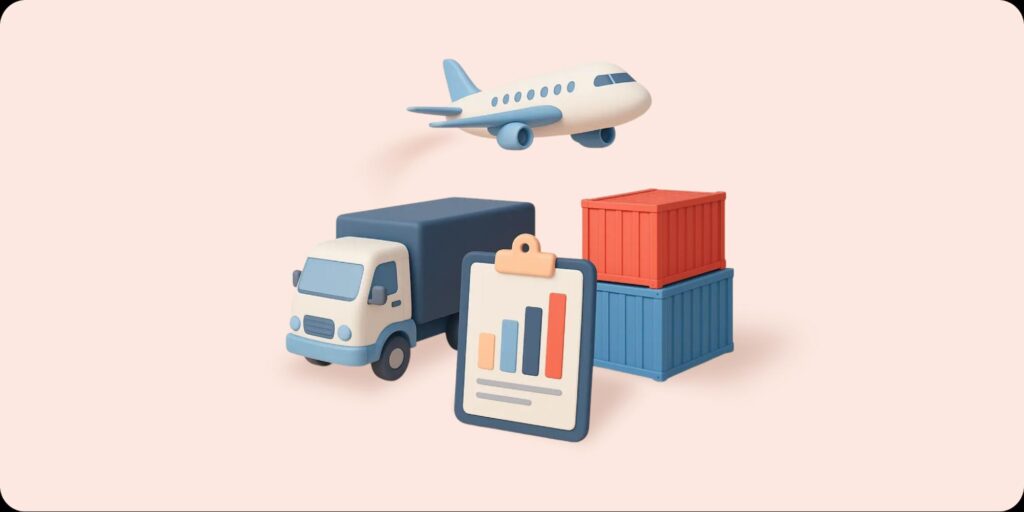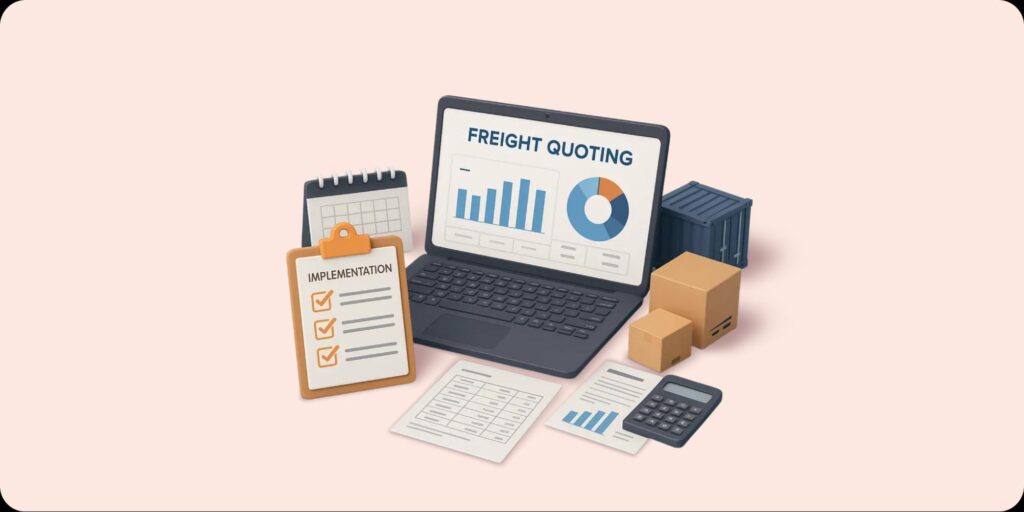Key Takeaways
- Top freight forwarders like Kuehne + Nagel, DHL, DSV, DB Schenker, and Sinotrans lead in volume, network reach, and reliable performance across major trade lanes.
- Leading global freight forwarders offer multimodal services, from air and ocean freight to warehousing and last-mile delivery, ensuring seamless end-to-end supply chain management.
- Success in forwarding today hinges on real-time tracking, compliance accuracy, and the ability to pivot across transport modes during disruptions.
- Wisor automates quoting, booking, and visibility workflows, reducing manual tasks and quote turnaround times by up to 85%, freeing forwarders to focus on growth and service.
- Choosing the right forwarder means vetting for global networks, tech capabilities, compliance expertise, and transparent pricing, which are key to avoiding delays and optimizing performance.
Top 10 Global Freight Forwarders in 2025
With hundreds of providers in the freight forwarding market, the landscape can feel overwhelming, especially for newcomers. Choosing the right partner requires diligent research, reading verified reviews, and comparing service scope, lanes, and pricing models.
To help, we compiled a ranking of the top freight forwarders, covering both ocean freight forwarders and air freight forwarders, in a single, practical list.
These companies deliver consistent performance at scale, manage high freight forwarding volumes, report strong gross logistics revenue, and, crucially, adapt quickly to market volatility and shifting trade conditions.
|
Rank |
Company | Headquarters | Estimated Ocean (TEUs) | Estimated Air (Metric Tons) |
Coverage |
| 1 | Kuehne + Nagel | Switzerland | ~4.3M | ~1.9M | Global |
| 2 | DHL Global Forwarding | Germany | ~3.3M | ~1.8M | Global |
| 3 | DSV | Denmark | ~2.7M | ~1.4M | Global |
| 4 | DB Schenker | Germany | ~1.8M | ~1.05M | Global |
| 5 | Sinotrans | China | ~4.8M | ~1.02M | Asia‑focused |
| 6 | Nippon Express | Japan | ~1.8M | ~0.92M | Asia‑Pacific |
| 7 | CEVA Logistics | France | ~1.90M | ~0.75M | Global |
| 8 | C.H. Robinson | USA | ~1.4M | ~0.31M | North America + global |
| 9 | Expeditors | USA | ~0.84M | ~0.87M | Global |
| 10 | Kerry Logistics | Hong Kong | ~1.2M | ~0.73M | Asia‑Pacific |
Key Services Offered by Top Freight Forwarders
Most people equate freight forwarders with transport, but modern forwarders provide far more. Leading providers act as end-to-end orchestrators, linking suppliers, carriers, customs, and customers into a unified supply chain. By combining transport, warehousing, brokerage, and compliance, top forwarders operate as problem-solvers, not just cargo movers. Their core services include:
- Air Freight Services: Speed is essential, particularly for e-commerce and high-value goods. Air cargo connects suppliers and buyers in days rather than weeks, and many global freight forwarders (e.g., DHL, UPS) operate or charter aircraft to secure lift capacity for electronics, pharmaceuticals, and fashion. With advanced track-and-trace systems, shippers gain real-time visibility into milestone events and exceptions.
- Ocean Freight Services: Despite growth in air cargo, ocean remains the most cost-efficient mode for large volumes. Leading forwarders work with major carriers to offer FCL and LCL solutions, plus specialized handling for vehicles, refrigerated cargo, and oversize/ODC shipments. Their deep port relationships and sailing options help keep volumes predictable and schedules as reliable as market conditions allow.
- Land Transport and Intermodal Solutions: Freight doesn’t stop at ports. Road and rail provide the essential first/last mile, and top forwarders offer intermodal solutions that combine modes to optimize time, cost, and emissions. This flexibility reduces handoffs, improves transit reliability, and keeps the wider supply chain moving smoothly.
- Warehousing and Distribution: Storage and handling form another very essential service. Contract logistics agreements allow companies to outsource inventory management, order picking, and distribution. Having this option helps businesses stay lean and benefit from the logistics services expertise of the major freight forwarding providers that we listed previously.
Freight Forwarding Process Explained
Freight forwarding runs on a defined playbook. Each shipment follows a structured path managed end-to-end by your forwarder – from booking through final delivery. These specialists coordinate every step to move goods across borders safely and on schedule. Understanding the workflow shows how it supports your business, where value is created, and where operational or compliance risks can arise.
Step 1: Booking and Documentation
The process begins by securing capacity with a carrier and assembling the required paperwork. Expect a substantial documentation set – commercial invoices, packing lists, HS codes, certificates, and licenses – that must be complete and accurate. The booking and documentation need to be organized to ensure that the shipment meets all of the carrier and customs requirements.
Many of the top freight forwarders automate this step with digital platforms like Wisor that help minimize errors and improve accuracy. Clear documentation helps prevent delays and supports compliance with trade regulations across the supply chain.
Step 2: Customs Handling
After booking is confirmed, attention shifts to customs brokerage and regulatory compliance to ensure cargo is export- and import-ready. Global freight forwarders prepare export/import declarations, confirm HS/tariff codes, and calculate duties and taxes. Because each destination has distinct rules and documentary requirements, precise, standards-aligned filings can save significant time at the border.
An experienced forwarder manages paperwork, interfaces with customs authorities, and proactively addresses queries, keeping goods moving and minimizing delays or storage charges.
Step 3: Cargo Management and Tracking
After the goods are cleared, they enter transit. An integrated logistics solution provider uses tools that give real-time updates on cargo, location, mode, and condition. These systems connect shippers, carriers, and customers under one digital view. This proactive management allows the forwarders to respond quickly to route changes and delays.
This improved visibility builds trust and reduces uncertainty along the supply chain, thus ensuring shipments reach the next checkpoint according to plan.
Step 4: Delivery and Last-Mile
The last and final step covers transport to the consignee. This step is also called last-mile delivery, and the process requires precise coordination between ports, warehouses, and local carriers. Freight forwarders arrange the unloading, inspection, and final dispatch to ensure that the goods arrive safely and right on schedule.
As the e-commerce market grows, this last stage becomes difficult because of the high freight forwarding volumes. It requires flexible routing and clear communication. All the top global freight forwarders treat this step as the most important because this is where customer experience meets operational performance.
Challenges Facing Freight Forwarders Today
As the logistics industry develops, new challenges emerge for companies battling in this very competitive market. Freight forwarders must navigate cost pressures, evolving trade rules, and customer demands for transparency, and also to improve supply chain management. All of these challenges are pushing providers to rapidly modernize and adapt.
- Rising Operational Costs: Inflationary pressure on fuel and energy, equipment, labor, and warehouse space drives costs up. Even when gross logistics revenue grows, margins can stay tight, pushing forwarders to optimize assets, procurement, and utilization.
- Complex Customs and Compliance: Every market has unique import/export rules. Without efficient brokerage and trade compliance, cargo sits idle at the border, incurring demurrage, detention, and storage. Strong process control and documentation discipline are essential.
- Limited Visibility in Traditional Models: Shippers now expect end-to-end, real-time tracking and predictive ETAs. Providers that rely on manual updates or siloed systems struggle to compete with forwarders offering API-driven visibility and proactive exception management.
- Growing Customer Expectations: E-commerce cycles and lean manufacturing demand faster SLAs, flexible options, and lower emissions. Forwarders must balance speed, reliability, and sustainability, often under pricing pressure, by investing in automation, analytics, and greener transport choices.
How to Identify the Right Freight Forwarder
Seeing a list of top freight forwarders can feel intimidating, but there’s a clear path to choosing the best fit for your business. A reliable partner should do more than move cargo – they should orchestrate your supply chain with transparency, compliance, and flexibility. The table below outlines the core factors that typically determine the right choice:
| Factor | Why It Matters |
What to Look For |
| Global Reach and Networks | Extensive coverage connects shippers to major trade lanes and markets, reducing handoffs and delays while keeping freight flowing to the destination. | Verify presence in strategic hubs, depth of carrier relationships, and the quality of local agency networks in each region you ship. |
| Range of Multimodal Services | A partner that can pivot across air, ocean, road, and rail maintains resilience when one mode faces disruption (e.g., port congestion or flight cancellations). | Confirm end-to-end capabilities – FCL/LCL, air freight, drayage, road/rail, and intermodal options – for seamless mode switching. |
| Technology and Real-Time Visibility | Modern platforms enable proactive planning, inventory control, and exception management. Real-time visibility reduces the risk of lost or delayed shipments. | Look for door-to-door tracking, automated booking and status updates, APIs, and dashboards with predictive ETAs and exception alerts. |
| Compliance and Certifications | Every corridor has distinct rules. Strong brokerage and trade compliance speed clearance and prevent costly penalties. | Seek recognized credentials (e.g., IATA, AEO, ISO 9001) and demonstrated expertise with HS codes, valuation, and documentary prep. |
| Transparent Pricing and Support | Clear pricing builds trust and enables accurate forecasting; responsive service keeps cargo moving when plans change. Financial strength reduces counterparty risk. | Expect itemized quotes, SLAs, 24/7 support for critical lanes, and evidence of financial stability (audited statements, insurance, bonding). |
How Wisor Empowers Top Freight Forwarders with Automation
AI and automation are reshaping forwarding operations. Wisor’s freight management software replaces manual steps with digital workflows, unlocking speed, accuracy, and actionable insight, so forwarders can scale efficiently without adding overhead.
- Automating Quotes and Bookings: Manual quoting can take hours (or days) and introduces inconsistency. Wisor automates rate sourcing, rules, and markup logic to return fast, accurate offers, helping forwarders win more business and smooth demand planning.
- Boosting Efficiency with AI: AI boosts efficiency with better routing, improved capacity, and optimizes the best rates. By analyzing data across the supply chain, Wisor gives freight forwarders the ability to respond quickly to any changes in demand or market disruptions.
- Eliminating Manual Workflows: There are many providers that still rely on the old-fashioned email, spreadsheet, and phone call combo. Wisor replaces these methods with digital workflows that deliver accuracy and speed up contract logistics operations.
- Delivering Real-Time, Data-Driven Insights: Accurate data underpins modern trade. Wisor integrates with carrier and transport systems to provide clear, live dashboards for shippers and forwarders alike, enabling end-to-end visibility, proactive exception handling, and performance improvement.
Conclusion
In 2025’s advanced, volatile market, forwarders that blend technology with operational expertise create outsized value. The leaders adapt to customer needs, manage costs, and invest in automation platforms like Wisor, standing out with faster workflows, lower error rates, and more predictable outcomes that strengthen the entire supply chain.
The role of freight forwarders has never been more pivotal: they connect global markets, manage risk, and keep goods flowing across air, ocean, rail, and road. The top providers invest heavily in networks, digital visibility, and services such as contract logistics and customs brokerage to deliver measurable business results.
For shippers, selecting the right partner hinges on reach, transparency, and innovation. By adopting automation with Wisor, forwarders improve efficiency, enhance reliability, and scale revenue opportunities, delivering the consistent performance customers expect in an ever-changing industry.







